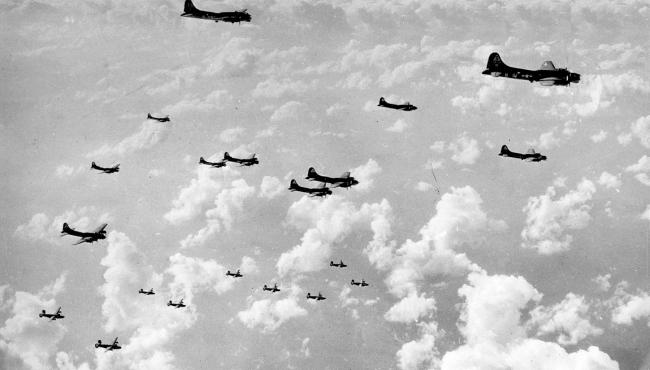42-37809 Carolina Queen

Family of Ball Guner Norman J. Fix
Object Number - UPL 78563 - 42-37809 Carolina Queen
Delivered Long Beach 6/9/43; Scott 22/10/43; Assigned 615BS/401BG [IY-G] Deenthorpe 26/10/43; Missing in Action Oschersleben 11/1/44 with Harry Chapman, Co-pilot: John Peck, Navigator: Harrison Hurlburt, Flight engineer/top turret gunner: Chas Badura, Radio Operator: Hugh Chaffin (5 Prisoner of War), Bombardier: Don Wallis, Ball turret gunner: Norman Fix, Waist gunner: Denzil Johnson, Waist gunner: Alf Marshall, Tail gunner: Francis Reed (5 Killed in Action); enemy aircraft severe damage, right wing broke off, crashed near Halberstadt, Ger; Missing Air Crew Report 2506. CAROLINA QUEEN.
Connections
See how this entry relates to other items in the archive by exploring the connections below.
Units served with

- Unit Hierarchy: Group
- Air Force: Eighth Air Force
- Type Category: Bombardment

- Unit Hierarchy: Squadron
- Air Force: Eighth Air Force
- Type Category: Bombardment
People
- Military/Civilian/Mascot: Military
- Nationality: American
- Unit: 401st Bomb Group 615th Bomb Squadron
- Highest Rank: Staff Sergeant
- Role/Job: Radio Operator
- Military/Civilian/Mascot: Military
- Nationality: American
- Unit: 401st Bomb Group 615th Bomb Squadron
- Highest Rank: Sergeant
- Role/Job: Top Turret Gunner
- Military/Civilian/Mascot: Military
- Nationality: American
- Unit: 401st Bomb Group 615th Bomb Squadron
- Highest Rank: Staff Sergeant
- Role/Job: Radio Operator
- Military/Civilian/Mascot: Military
- Nationality: American
- Unit: 401st Bomb Group 615th Bomb Squadron
- Highest Rank: Lieutenant
- Role/Job: Pilot

- Military/Civilian/Mascot: Military
- Nationality: American
- Unit: 401st Bomb Group 615th Bomb Squadron
- Highest Rank: Staff Sergeant
- Role/Job: Ball Turret Gunner
Places

- Site type: Airfield
- Known as: Benefield
Missions
- Date: 11 January 1944

- Date: 5 January 1944

- Date: 31 December 1943

- Date: 30 December 1943
- Date: 24 December 1943
Events
| Event | Location | Date | Description |
|---|---|---|---|
|
Other Failed to Return (FTR) |
11 January 1944 |


